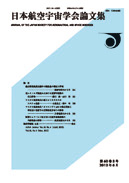All issues

Volume 28, Issue 312
Displaying 1-7 of 7 articles from this issue
- |<
- <
- 1
- >
- >|
-
Masami IKEUCHI, Yoshiaki HAYAKAWA1980 Volume 28 Issue 312 Pages 1-7
Published: January 05, 1980
Released on J-STAGE: May 25, 2009
JOURNAL FREE ACCESSDownload PDF (451K) -
Hiromu KASHIHARA, Shin-ichi HANAKI1980 Volume 28 Issue 312 Pages 8-10
Published: January 05, 1980
Released on J-STAGE: May 25, 2009
JOURNAL FREE ACCESSDownload PDF (983K) -
Akio ICHIKAWA, Shigenori ANDO1980 Volume 28 Issue 312 Pages 11-18
Published: January 05, 1980
Released on J-STAGE: May 25, 2009
JOURNAL FREE ACCESSIn the previous our paper the accuracy of numerical method for steady two dimensional lifting surfaces in an incompressible inviscid flow was investigated. In this paper the work is extended to unsteady cases, where the kernel function includes the logarithmic singularity.
The difficulty becomes severe as the reduced frequency increases. It is found that careless treatments of this singularity make numerical calculation impractical even for low values of the reduced frequency, say larger than two or three. Through appropriate manipulation of this singularity, drastic improvement of the accuracy of numerical solutions is established.View full abstractDownload PDF (422K) -
Yoshihiro MINAMI, Koichi KASUYA, Keishiro NIU1980 Volume 28 Issue 312 Pages 18-25
Published: January 05, 1980
Released on J-STAGE: May 25, 2009
JOURNAL FREE ACCESSThis paper deals with numerical analyses of the flows in a bow shock wave (B.S.W.)-nozzle system which is applied to the gasdynamic laser (G.D.L.). In the B.S.W.-nozzle system, the dissociation of CO2 or N2 molecules of the gas is suppressed even if the gas after the B.S.W. is heated up to 2, 000-5, 000K, since the gas is cooled rapidly expanding through the nozzle.
Numerical calculations for such flow fields lead us to the estimation of the capability and the optimum conditions of such G.D. Ls. It is turned out in our system that the mole-fractions of CO2can be elevated to 20%, and the small signalgain coefficients increase more than four or five times (3.8m-1) than those of conventional G.D. Ls.View full abstractDownload PDF (470K) -
Apply the Polyamid FeltRyohei SASAKI1980 Volume 28 Issue 312 Pages 25-35
Published: January 05, 1980
Released on J-STAGE: May 25, 2009
JOURNAL FREE ACCESSThe acoustic treatment for noise reduction of turbofan engine is mainly installed to the internal wall of fan duct and absorbs the noise which is propagating thrum the duct.
In the case of high bypass ratio turbofan engine for the aircraft, peak frequency of fan noise depends on engine rotational speed and resonate type acoustic treatment modulated for take off rating is usually not effective for approach ratmg.
From this reason, the broad band homogeneous type acoustic treatment is required, and author is studying to utilize the polyamid felt for acoustic treatment for this purpose.
Test result showed that this kind of broad band treatment is effective for both take off and approach in reduction of fan noise, and durability of this felt is also demonstrated in the actual engines.View full abstractDownload PDF (1106K) -
Tyozi HORIKOSHI1980 Volume 28 Issue 312 Pages 36-41
Published: January 05, 1980
Released on J-STAGE: May 25, 2009
JOURNAL FREE ACCESSConcerning the internal flow of the reattaching side of the fluid amplifier with the splitter only, by the conformal mapping, the theoretical analysis has been performed in the followings, applying the potential flow theory:
(1) approximately replacing the side wall of the splitter with the finite number of vortex, placed in the same intervals.
(2) placing a vortex near the side wall, to obtain the reattaching phenomenon.
By this analysis, the approximate solution of the stream line and the pressure distribution have been able to obtain. Experimental values of the reattaching stream line and the pressure distribution were examined with the theoretical values of this analysis.View full abstractDownload PDF (258K) -
Junjiro ONODA1980 Volume 28 Issue 312 Pages 41-46
Published: January 05, 1980
Released on J-STAGE: May 25, 2009
JOURNAL FREE ACCESSAn analytical investigation of the effect of a circular hole on the buckling of thin cylindrical shell under axial compression was carried out. The prebuckling stress was obtained from DONNELL's equation using a collocation method, and a RAYLEIGH-RITZ approximation was used to derive the buckling load. The comparison with some reported experimental results proved that the result obtained is reasonable for a relatively small hole. The result was substantially improved than previous analytical results given by the stress around a hole in infinite plate as an approximation of prebuckling stress.View full abstractDownload PDF (302K)
- |<
- <
- 1
- >
- >|